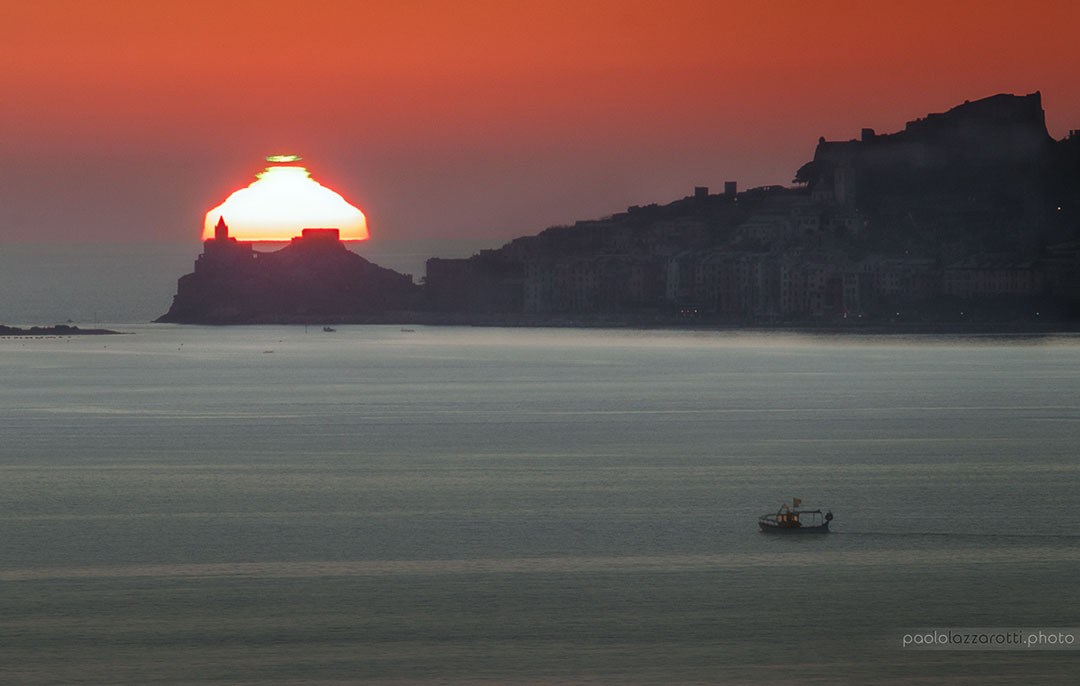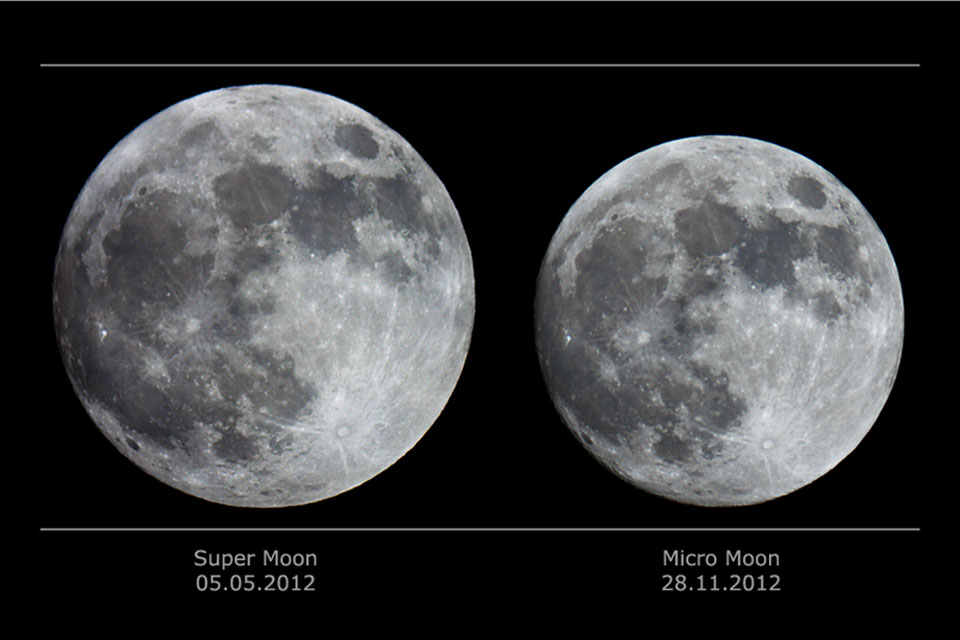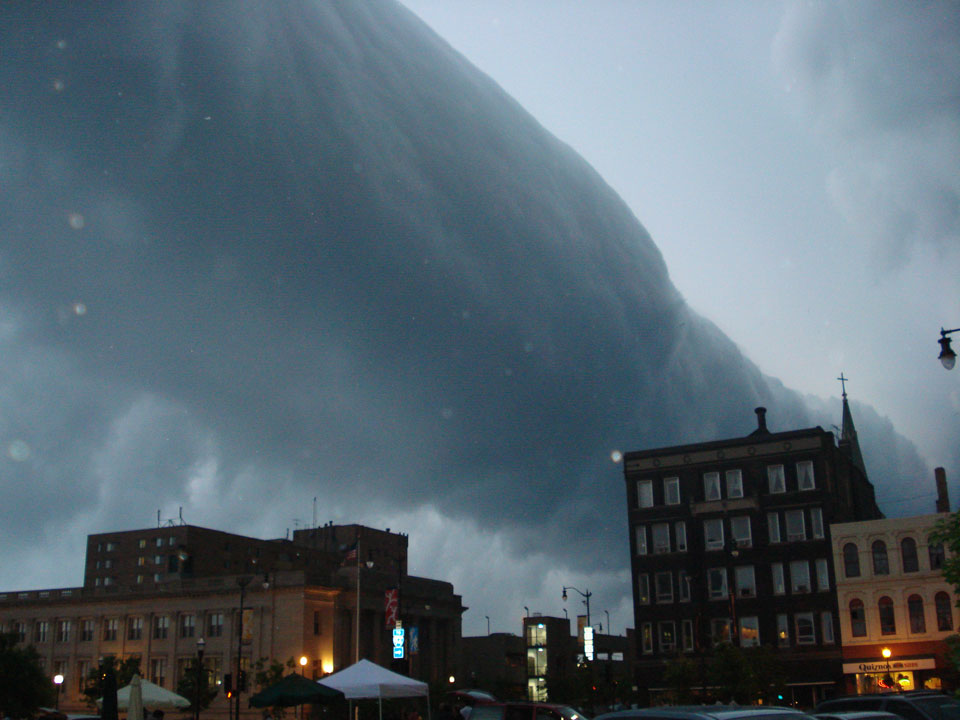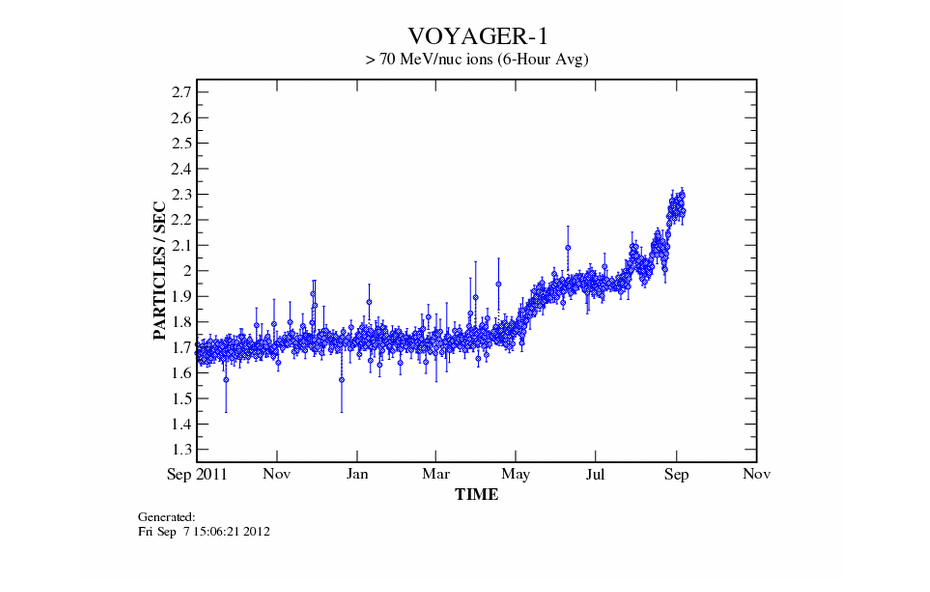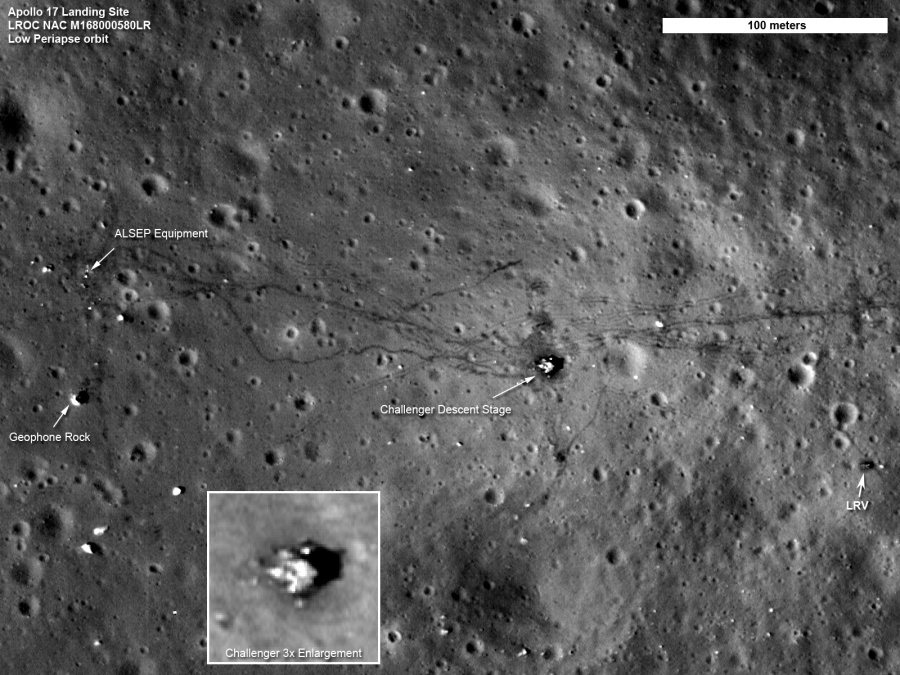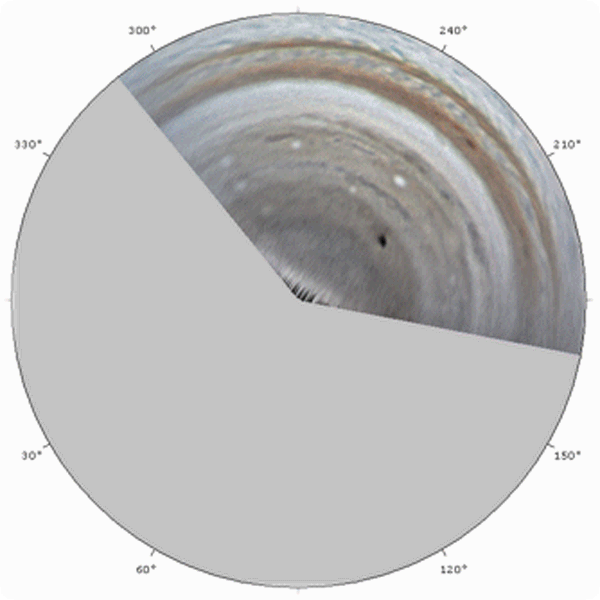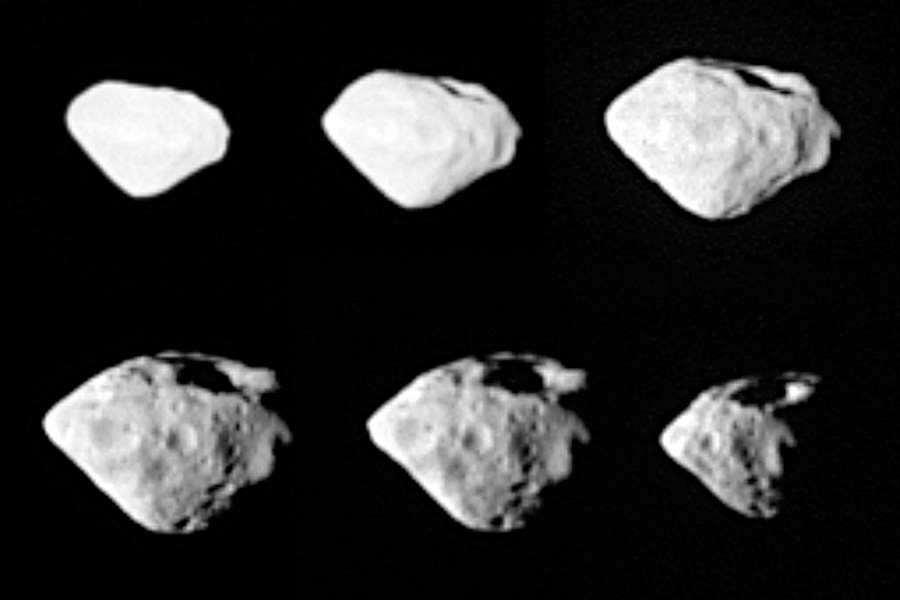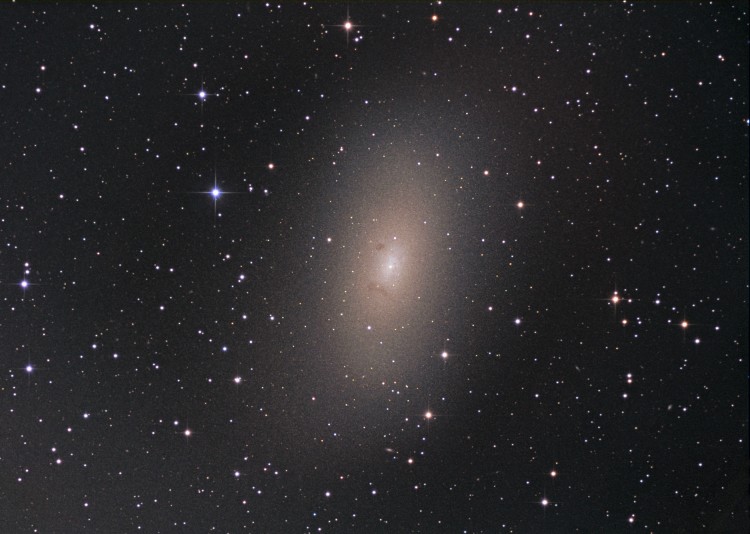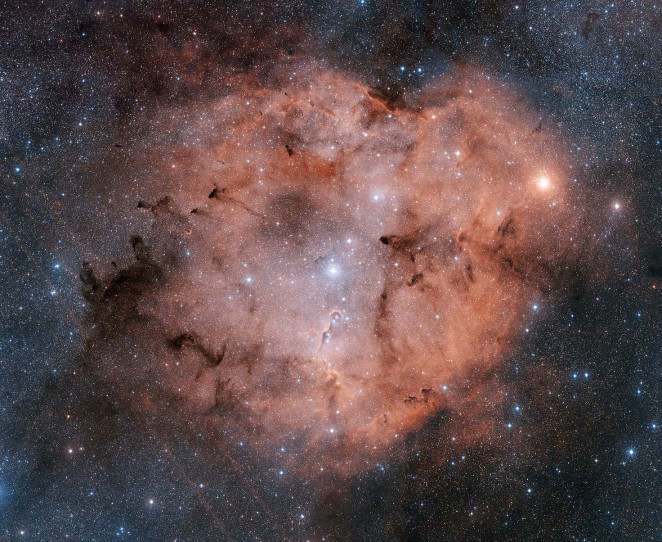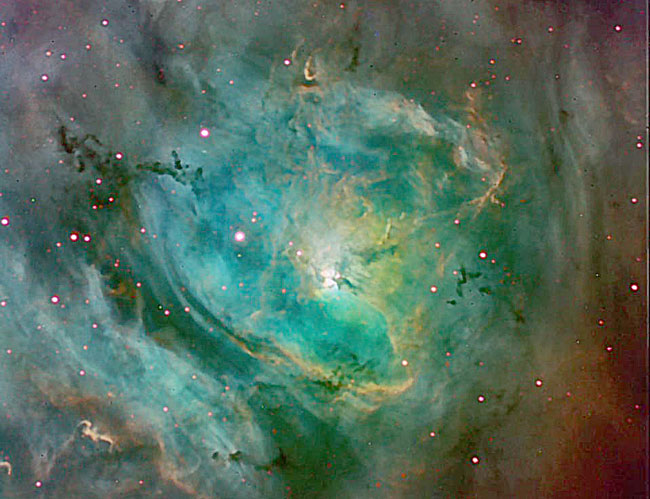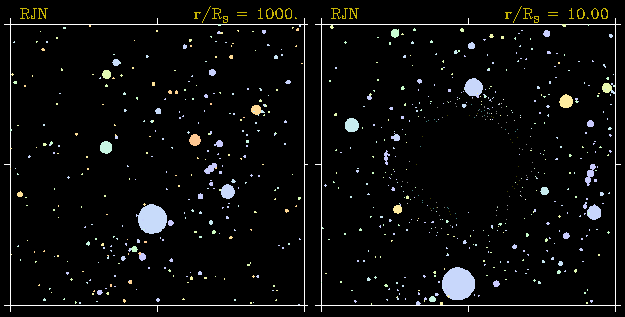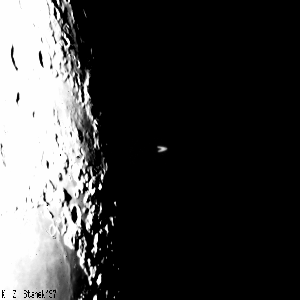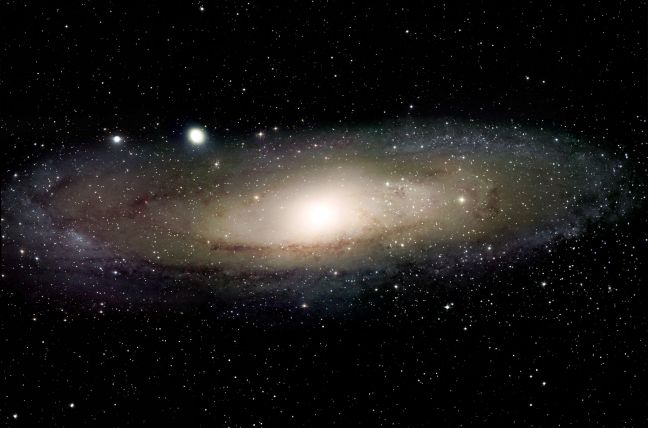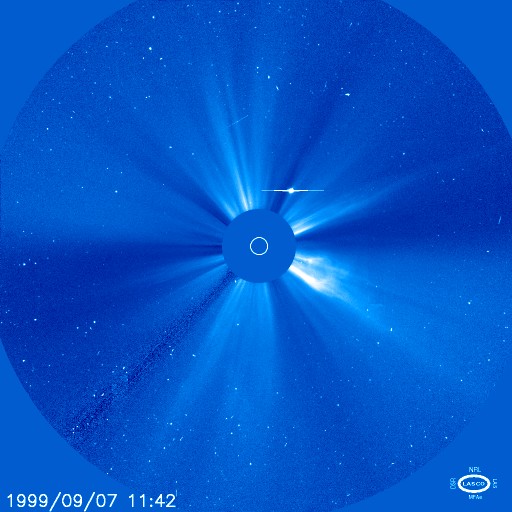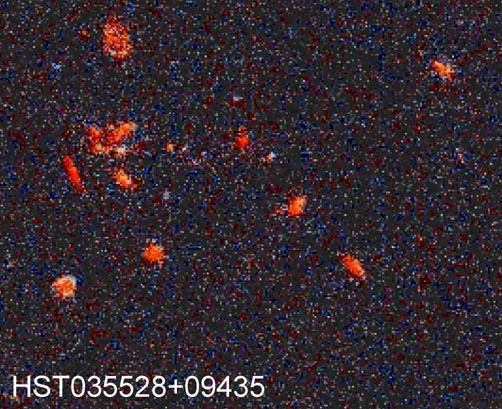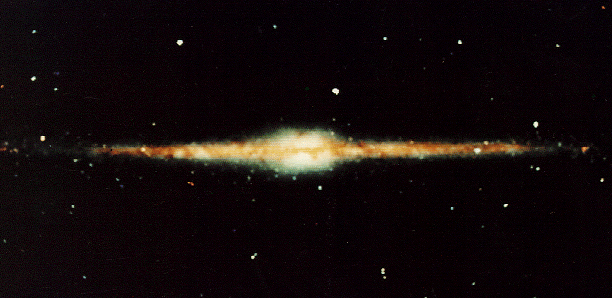| << Previous | Index | Next >> |
2015 This was one strange sunset. For one thing, the typically round Sun appeared distorted, geometrically, and multiply layered. For another, some of these layers appeared unusually green. The Sun, of course, was just fine -- its odd appearance was caused entirely by its light refracting in the Earth's atmosphere. When layers of the Earth's atmosphere are unusually warm, layers of the Sun may appear distorted or even seen multiple times. The effect is most strong nearest sunrise and sunset when terrestrial inversion layers occupy distinct altitudes above the horizon. Different colors of the Sun may also become deflected by significantly different amounts, so that the uppermost superior image may appear momentarily green -- a phenomenon known as a green flash. The featured image was taken in February from Porto Venere, Italy, with San Pietro church situated in the foreground.
2014 What is so super about tomorrow's supermoon? Tomorrow, a full moon will occur that appears slightly larger and brighter than usual. The reason is that the Moon's fully illuminated phase occurs within a short time from perigee - when the Moon is its closest to the Earth in its elliptical orbit. Although the precise conditions that define a supermoon vary, given one definition, tomorrow's will be the third supermoon of the year -- and the third consecutive month that a supermoon occurs. One reason supermoons are popular is because they are so easy to see -- just go outside and sunset and watch an impressive full moon rise! Since perigee actually occurs today, tonight's sunset moonrise should also be impressive. Pictured above, a supermoon from 2012 is compared to a micromoon -- when a full Moon occurs near the furthest part of the Moon's orbit -- so that it appears smaller and dimmer than usual. Given many definitions, at least one supermoon occurs each year, with the next being 2015 August 30.
2013 What kind of cloud is this? A type of arcus cloud called a roll cloud. These rare long clouds may form near advancing cold fronts. In particular, a downdraft from an advancing storm front can cause moist warm air to rise, cool below its dew point, and so form a cloud. When this happens uniformly along an extended front, a roll cloud may form. Roll clouds may actually have air circulating along the long horizontal axis of the cloud. A roll cloud is not thought to be able to morph into a tornado. Unlike a similar shelf cloud, a roll cloud is completely detached from their parent cumulonimbus cloud. Pictured above, a roll cloud extends far into the distance as a storm approached in 2007 in Racine, Wisconsin, USA.
2012 Launched on a grand tour of the outer planets in 1977, by good fortune the twin Voyager spacecraft were also headed in the general direction of the Sun's motion relative to nearby stars. Thirty five years later, Voyager 1 appears to be nearing the boundary of the Sun's heliosphere and interstellar space. Of course the heliosphere is the realm of the Sun defined by the influence of the solar wind and the Sun's magnetic field. But how can you tell when your spacecraft crosses the boundary into interstellar space? One clue would be a sudden increase in the detection of energetic cosmic rays. The high energy particles stream through interstellar space accelerated by distant supernovae in our galaxy, but are normally deflected or slowed by the heliosphere. Covering a 12 month period (September 2011 to 2012), this plot does show a dramatic increase in the rate of cosmic ray particle detection in past months by the Voyager 1 spacecraft. Voyager 1 is now 18 billion kilometers (17 light hours, 122 Astronomical Units) from the Sun and may soon be the first spacecraft from Earth to enter the realm of the stars.
2011 This view of the Apollo 17 landing site in the Taurus-Littrow valley was captured last month by the Lunar Reconnaissance Orbiter (LRO), the sharpest ever recorded from space. The high resolution image data was taken during a period when LRO's orbit was modified to create a close approach of about 22 kilometers as it passed over some of the Apollo landing sites. That altitude corresponds to only about twice the height of a commercial airline flight over planet Earth. Labeled in this image are Apollo 17 lunar lander Challenger's descent stage (inset), the lunar rover (LRV) at its final parking spot, and the Apollo Lunar Surface Experiments Package (ALSEP) left to monitor the Moon's environment and interior. Clear, dual lunar rover tracks and the foot trails left by astronauts Eugene Cernan and Harrison Schmitt, the last to walk on the lunar surface, are also easily visible at the Apollo 17 site.
2010
[imghover6=http://apod.nasa.gov/apod/image/1009/ngc4911_hst.jpg]http://apod.nasa.gov/apod/image/1009/ng ... otated.jpg[/imghover6]Credit: NASA, ESA, and the Hubble Heritage Team (STScI/AURA); Acknowledgment: K. Cook (LLNL) et al.
2009 Two months ago, something unexpected hit Jupiter. First discovered by an amateur astronomer Anthony Wesley on 2009 July 19, the impact was quickly confirmed and even imaged by the Hubble Space Telescope during the next week. Many of the world's telescopes then zoomed in on our Solar System's largest planet to see the result. Some of these images have been complied into the above animation. Over the course of the last month and a half, the above time-lapse sequence shows the dark spot -- first created when Jupiter was struck -- deforming and dissipating as Jupiter's clouds churned and Jupiter rotated. It is now thought that a small comet -- perhaps less than one kilometer across -- impacted Jupiter on or before 2009 July 19. Although initially expected to be visible for only a week, astronomers continue to track atmospheric remnants of the impact for new information about winds and currents in Jupiter's thick atmosphere.
2008 What's that diamond in the sky? Cruising though space, sometimes you'll come across an unusual object. Such was the case on Friday for ESA's Rosetta spacecraft on its way to comet Churyumov-Gerasimenko in 2014. Robotic Rosetta buzzed right by the main belt asteroid 2867 Šteins, taking many pictures, some of which have been compiled into a short video. At first glance, Steins looked like a 5-kilometer wide diamond, but as Rosetta shot by, craters and a more extended shape become evident. In the above sequence of six images, a notable chain of craters is evident vertically on the asteroid's surface, most probably caused by a chance collision with a stream of meteors. Space scientists will now study the data taken by Rosetta of asteroid Steins in an effort to better understand its composition, origin, and why the asteroid reflects light so well. As the Earth-bound scientists toil, Rosetta itself will continue to zoom across our Solar System, next swooping again by the Earth in 2009 November, flying by asteroid 21 Lutetia in 2010 July, and finally landing on comet Churyumov-Gerasimenko in 2014 November.
2007 Launched thirty years ago, NASA's Voyager 1 and 2 spacecraft are now respectively 15 and 12.5 billion kilometers from the Sun, equivalent to about 14 and 11.5 light-hours distant. Still functioning, the Voyagers are being tracked and commanded through the Deep Space Network. Having traveled beyond the outer planets, they are only the third and fourth spacecraft from planet Earth to escape toward interstellar space, following in the footsteps of Pioneer 10 and 11. A 12-inch gold plated copper disk (a phonograph record) containing recorded sounds and images representing human cultures and life on Earth, is affixed to each Voyager - a message in a bottle cast into the cosmic sea. The recorded material was selected by a committee chaired by astronomer Carl Sagan. Simple diagrams on the cover symbolically represent the spacecraft's origin and give instructions for playing the disk. The exotic construction of the disks should provide them with a long lifetime as they coast through interstellar space.
2006 This very sharp telescopic vista features the last object in the modern version of Charles Messier's catalog of bright clusters and nebulae - Messier 110. A dwarf elliptical galaxy, M110 (aka NGC 205) is actually a bright satellite of the large spiral galaxy Andromeda, making M110 a fellow member of the local group of galaxies. Seen through a foreground of nearby stars, M110 is about 15,000 light-years across. That makes it comparable in size to satellite galaxies of our own Milky Way, the Large and Small Magellanic Clouds. Though elliptical galaxies are normally thought to be lacking in gas and dust to form new stars, M110 is known to contain young stars, and faint dust clouds can easily be seen in this detailed image at about the 7 and 11 o'clock positions relative to the galaxy center.
2005
2004 Why do some black hole surroundings appear brighter than others? In the centers of active galaxies, supermassive black holes at least thousands of times the mass of our Sun dominate. Many, called Seyfert Type I, are very bright in visible light. Others, called Seyfert Type II, are rather dim. The difference might be caused by some black holes accreting much more matter than others. Alternatively, the black holes in the center of Seyfert Type II galaxies might be obscured by a surrounding torus. To help choose between these competing hypotheses, the nearby Seyfert II galaxy NGC 4388 has been observed in X-ray light recently by many recent Earth-orbiting X-ray observatories, including CGRO, SIGMA, BeppoSAX, INTEGRAL, Chandra, and XMM-Newton. Recent data from INTEGRAL and XMM-Newton have found that the X-ray flux in some X-ray colors varies rapidly, while flux in other X-ray colors is quite steady. The constant flux and apparent absorption of very specific X-ray colors by cool iron together give evidence that the central black hole in NGC 4388 is seen through a thick torus composed of molecular gas and dust.
2003 The large majestic Lagoon Nebula is home for many young stars and hot gas. Spanning 100 light years across while lying only about 5000 light years distant, the Lagoon Nebulae is so big and bright that it can be seen without a telescope toward the constellation of Sagittarius. Many bright stars are visible from NGC 6530, an open cluster that formed in the nebula only several million years ago. The greater nebula, also known as M8 and NGC 6523, is named "Lagoon" for the band of dust seen to the left of the open cluster's center. A bright knot of gas and dust in the nebula's center is known as the Hourglass Nebula. The above picture is a digitally sharpened composite of exposures taken in specific colors of light emitted by sulfur (red), hydrogen (green), and oxygen (blue). Star formation continues in the Lagoon Nebula as witnessed by the many globules that exist there.
2002 What would you see if you went right up to a black hole? Above are two computer generated images highlighting how strange things would look. On the left is a normal star field containing the constellation Orion. Notice the three stars of nearly equal brightness that make up Orion's Belt. On the right is the same star field but this time with a black hole superposed in the center of the frame. The black hole has such strong gravity that light is noticeably bent towards it - causing some very unusual visual distortions. In the distorted frame, every star in the normal frame has at least two bright images - one on each side of the black hole. In fact, near the black hole, you can see the whole sky - light from every direction is bent around and comes back to you. Black holes are thought to be the densest state of matter, and there is indirect evidence for their presence in stellar binary systems and the centers of globular clusters, galaxies, and quasars.
2001 On September 18, 1997, many stargazers in the U. S. were able to watch a lovely early morning lunar occultation as a bright Moon passed in front of Saturn. Using a 1.2 meter reflector, astronomer Kris Stanek had an excellent view of this dream-like event from the Whipple Observatory atop Arizona's Mount Hopkins. This animated gif image was constructed by Wes Colley from 4 frames taken by Stanek at 35 second intervals as the ringed planet emerged from behind the Moon's dark limb. While lunar occultations of fairly bright stars and planets are not extremely rare events, their exact timing depends critically on the observer's location. For observers in western North America, the Moon will next occult Saturn on Monday morning, September 10.
2000 How far can you see? The most distant object easily visible to the unaided eye is M31, the great Andromeda Galaxy some two million light-years away. Without a telescope, even this immense spiral galaxy appears as an unremarkable, faint, nebulous cloud in the constellation Andromeda. But a bright yellow nucleus, dark winding dustlanes, gorgeous blue spiral arms and star clusters are recorded in this stunning telescopic digital mosaic of the nearby island universe. While even casual skygazers are now inspired by the knowledge that there are many distant galaxies like M31, astronomers seriously debated this fundamental concept only 80 years ago. Were these "spiral nebulae" simply outlying components of our own Milky Way Galaxy or were they instead "island universes" -- distant systems of stars comparable to the Milky Way itself? This question was central to the famous Shapley-Curtis debate of 1920, which was later resolved by observations of M31 in favor of Andromeda, island universe.
1999 In astronomical parlance, an interior planet is at superior conjunction when it is located on the opposite side of the Sun from Earth. Mercury, the solar system's innermost planet, zips past this point in its orbit today. In fact, this recent picture from a solar coronagraph on board the the space-based SOHO observatory shows Mercury positioned very close to the Sun as seen from a near Earth vantage point. The coronagraph uses an internal occulting disk to block the intense solar glare which otherwise hides this sight from ground-based observers. The shadow of the occulting disk is at the center with the Sun's size and position indicated by the white circle. Mercury is the bright dot with a horizontal line (a digital artifact), while faint dots scattered throughout the field are stars. Bright regions of the sun's outer atmosphere are also visible. As Mercury continues in its orbit, on November 15 it will actually appear to cross the disk of the Sun as viewed from Earth.
1998 Why is this galaxy cluster so red? Nearby clusters have galaxies with colors that are much more yellow and blue. A leading explanation is that this cluster of galaxies lies so far across our universe (z~1) that cosmological time dilation significantly reddens the light. If true, this cluster might lie too far away to have formed in a dense universe, implying that our universe is not very dense. HST 035528+09435 is one of the reddest clusters found in the Hubble Space Telescope's Medium Deep Survey. Astronomers will now work to confirm the high distance to this cluster, and contemplate what it signifies about the nature of our universe.
1997 Vesta is a huge rock 500 kilometers across that orbits out past Mars. Last week, the above map of Vesta created using the Hubble Space Telescope was released showing a rugged surface highlighted by a single crater spanning nearly the entire length of the asteroid. The large crater dominates the lower part of the false-color conglomerate image: blue indicates low terrain, while red indicates raised terrain. Evidence indicates that Vesta underwent a tremendous splintering collision about a billion years ago. In October 1960, a small chunk of this rock believed to have originated on Vesta fell to Earth and was recovered in Australia.
1996 Jupiter's moon Io is turning out to be our Solar System's geologic powerhouse. The churning moon was photographed again just recently on June 27th and again shows signs of violent activity. Shown above are photographs of the volcano Euboea Fluctus taken at different times. The black and white photograph on the upper left was taken by the Voyager 1 spacecraft when it flew by in 1979, the upper right and lower left photographs were taken in 1996 by the Galileo spacecraft, while the lower right photograph is a color image taken by Voyager 2, also in 1979. The upper right Galileo picture has been artifically changed to simulate the color sensitivity of the Voyager 2 mission. The marked difference in the two images is highlighted by new red and yellow deposits. These markings may indicate that Euboea Fluctus erupts in an unusual fashion, possibly caused by an obstruction near the volcanic vent.
1995 NASA's COBE satellite scanned the heavens at infrared wavelengths in 1990 and produced this premier view of the central region of our own Milky Way Galaxy. The Milky Way is a typical spiral galaxy with a central bulge and extended disk of stars. However, gas and dust within the disk obscure visible wavelengths of light effectively preventing clear observations of the center. Since infrared wavelengths, are less affected by the obscuring material, the Diffuse InfraRed Background Experiment (DIRBE) on board COBE was able to detected infrared light from stars surrounding the galactic center and produce this image. Of course, the edge on perspective represents the view from the vicinity of our Sun, a star located in the disk about 30,000 light years out from the center. The DIRBE experiment used equipment cooled by a tub of liquid helium to detect the infrared light which, composed of wavelengths longer than red light, is invisible to the human eye.
| << Previous | Index | Next >> |
